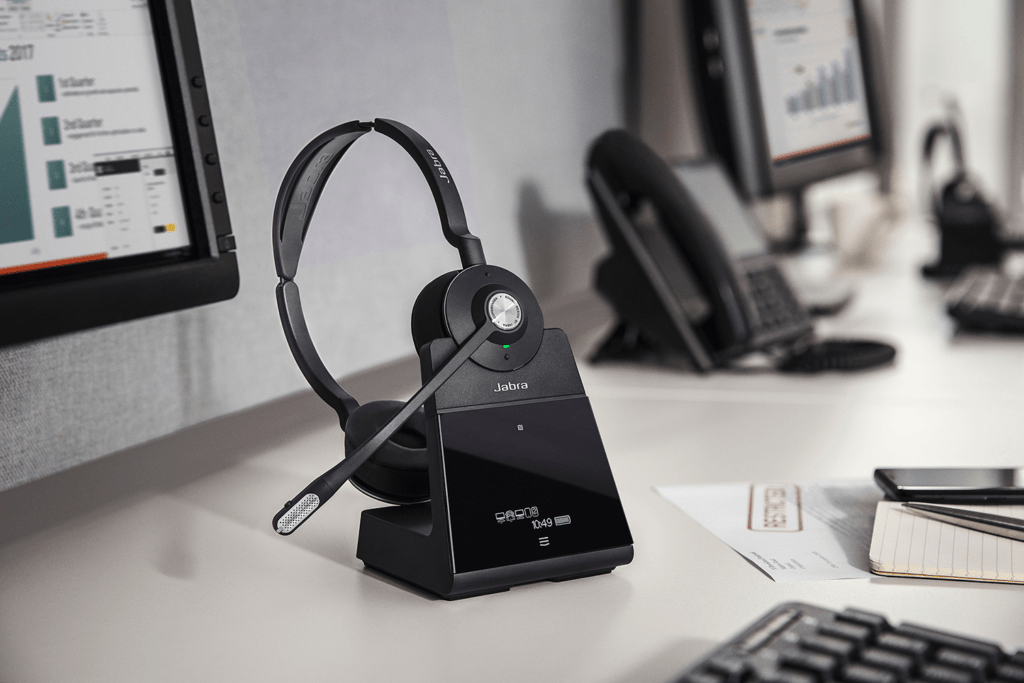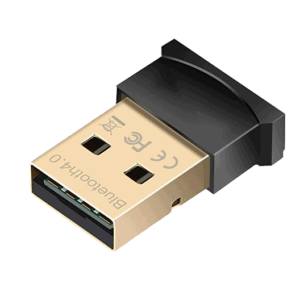Last updated on February 17th, 2023 at 04:25 pm
The major advantage of a wireless office headset is the ability to take calls or move away from your telephone during a call.
Wireless headsets are quite common in office use today as they give the user freedom to move around whilst on a call, so for people who do need the ability to be able to be away from a desk whilst keeping the ability to answer calls, then a Wireless Headset could be the perfect option.
Wireless Headsets are perfect for: Sales staff, Warehouse managers, Reception staff or anybody else who absolutely needs the freedom to be able to be hands free and mobile whilst taking calls in the office.
There’s a few things worth knowing before investing in a Wireless Headset for Office Telecoms use so we hope our guide goes some way to clearing up some of the varied options available.
Table of Contents
How many types of Wireless Office Headset are there?
There are two types of cordless headset to be aware about.
Professional level DECT wireless office headsets
These are designed to be used for fixed Office Telephones, Softphones, VoIP (Voice Over Internet Protocol) phones and PCs. These types of wireless headsets usually come in two parts:
- The headset itself which is fitted with a rechargeable battery.
- The base unit which connects to the telephone via a cord, and (if compatible) the PC via USB cable or Bluetooth. The base unit acts as the receiver and charger unit for the headset itself.
The headset, in this case, is communicating with the base unit to send its signal to the comms device – these headsets almost always use *DECT technology to communicate wirelessly between headset and base unit.
*There are a few Bluetooth only models available that function in the same way.

Standard Bluetooth office headsets
These are primarily designed for mobile phones and/or PCs and are usually supplied with only the headset and charging cable or charging pod – it is the headset using Bluetooth technology to connect to the mobile or PC device directly.
Bluetooth headsets come in many forms, from the modern style; Apple AirPods or Google PixelBuds to the earpiece style shown in the image below, to headsets with neckbands to wear whilst exercising, to full headband headsets.
Bluetooth headsets are very much multi-functional, and are commonly used for listening to music on the go and for taking & making calls.

What is the difference between DECT and Bluetooth wireless office headsets?
DECT Wireless Headsets use the same technology as Cordless DECT Phones, and allows for superior range and sound clarity, whilst Bluetooth headsets use the ubiquitous wireless standard that is common in most mobile phones plus lots of PC’s and laptops today. There are advantages and disadvantages of both, and some instances where the technologies are combined so it is worth knowing about these before you make your choice.
DECT
DECT Wireless Headsets send their signal to and from the base unit on the 2.4Ghz frequency and have superb range! The DECT standard means that they can reach up to 200 metres where there are little or no obstacles in the way of blocking the radio signal between headset and base unit, so open plan offices are amazing for these units. It is typical to get between 30-60 metres indoors where there are walls or other obstacles present, which is still a substantial distance in most offices. DECT also offers a higher bandwidth in terms of transmission allowing a wideband sound spectrum, so voice quality is often higher than Bluetooth options.
If you would like to know more detailed technical information about the DECT standard, you can find out more on Wikipedia’s DECT information page.
Bluetooth

The second type of wireless that is slightly more familiar is Bluetooth, also working on the 2.4Ghz radio frequency.
The Bluetooth standard runs a shorter range than DECT and is limited to approximately 30 metres max, which does reduce quite sharply with walls & obstacles, so users tend to get between 5-10 meters. You do need to be aware of range limitations here as DECT does offer the superior range over Bluetooth, however the ubiquity and versatility of the software built-in with Bluetooth technology gives you the opportunity in a lot of cases of having the headset itself directly paired to multiple devices at the same time without the need of a base unit.
The user can in a lot of cases, have the headset paired to their corded phone base unit, mobile phone, and PC, so if they would like the ability to switch between a Teams meeting on the PC, to a call on their desktop handset, then Bluetooth might be the better technology in this use case.
There are two types of Bluetooth headsets that you can buy.
- Bluetooth headsets that charge via a cable (Via a USB-A or USB-C Connection) or wirelessly. These normally connect directly to the PC / Mobile or Tablet via the inbuilt Bluetooth adapter.
- The other type of Bluetooth headset comes with a Charging base, and is designed to be used at a desk, so the user can easily charge their headset between calls. These types of headsets connect directly to a PC, Mobile or Laptop via Bluetooth.
It is worth noting some older PC’s that do not have a Bluetooth would need a USB Bluetooth Dongle to pair with their blueooth headset.
A bluetooth dongle is a tiny device that plugs into any free USB port on your PC or Laptop and will give you the ability to pair any Bluetooth device to your computer.

More in depth technical information about Bluetooth can be found on Wikipedia’s Bluetooth information page.
An example of a Bluetooth headset for corded telephones and mobile devices would be the excellent Project Telecom Advanced Monaural Wireless Bluetooth Headset
Can DECT & Bluetooth work in tandem?
Some Wireless headsets work using DECT technology and Bluetooth in tandem which gives the advantage of the extra range, whilst also adding the flexibility of Bluetooth. The way they incorporate both technologies is to incorporate Bluetooth into the headset’s base unit. This allows the user to connect a nearby mobile device or Bluetooth enabled PC or Laptop to the headset’s base unit which in turn connects to the DECT headset.
In these cases, the Bluetooth device pairs to the headset’s base unit, whilst the headset base unit then goes on to connect to the headset using DECT, giving the benefit of that DECT range whilst connected to a Bluetooth device.
The Jabra Engage 75 and the Plantronics Savi W8220 are a good examples of high quality cordless DECT headset which can connect to multiple devices and have a Bluetooth enabled base unit.
Can I answer my telephone from my cordless headset if I am away from my desk?
Depending on the make and model of your desktop telephone, you may need to buy an added accessory to enable your Wireless Headset to answer and end your calls using the button on the headset.
Older phones need a more mechanical solution call a Handset lifter. A headset lifter automatically lifts the handset on the phone for you when you choose to take a call with the headset. It directs the audio to the headset. It means that you can answer or end a call with your headset when you are away from the phone i.e., in another room. Almost all analogue telephones will require a lifter.
If you have a more modern office phone, that is IP, VoIP or Digital (ISDN) then you will most likely have something called an EHS Mode built into your telephone. EHS means Electronic Hook Switch and does the same job as its predecessor the lifter, but it is completely electric, so no moving parts. You will need to find the correct EHS cable for your telephone, as this can vary depending on the make of your Wireless Headset.
We recommend giving our team a call on 0161 737 9898 to check which EHS cable you need.
Summary
We hope you have found some of the information in our article useful, we’ve set this up to ask some of the most common questions we get asked to help explain the benefits of WIreless Headsets, but if you have any more questions, then please don’t hesitate to call the team here at PMC Telecom.
0161 737 9898

